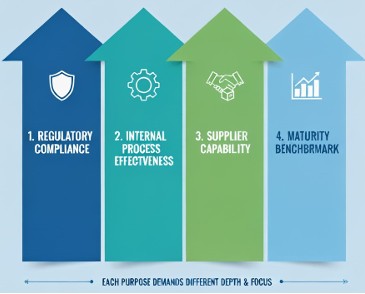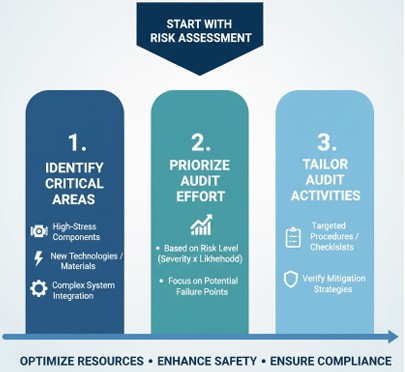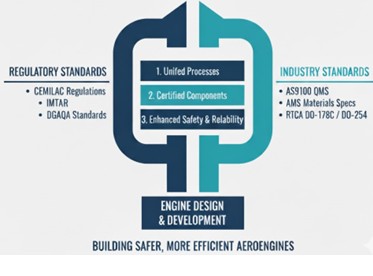By Suneel Kumar
Aeroengine development is one of the most complex domains in engineering. It integrates disciplines such as advanced thermodynamics, aerodynamics, materials science, control systems, and safety-critical software into products. Hence, it demands precision, traceability, and strict compliance with regulatory and safety standards.
Performance, operability, airworthiness, and reliability are affected by design decisions. For organizations in this domain, audits are not just compliance exercises. They are strategic tools to ensure product integrity, operational efficiency, and long-term competitiveness. Done well, they are a strategic tool to strengthen processes and reduce risks.
This article provides an overview of the effective audit strategies that enhance engineering
quality assurance during the development of an aeroengine.
Strategy 1: define the audit purpose clearly
Before planning begins, the audit purpose is established to confirm whether it is for regulatory compliance, assessing internal process effectiveness, evaluating supplier capability, or benchmarking maturity, as seen in figure 1.

Clarity of purpose prevents audits from becoming box-ticking exercises and ensures they generate insights that management can act on.
Strategy 2: risk-based auditing
All activities do not carry equal weight in terms of risk level.
Tasks like design of critical modules and parts, stress analysis, project management, quality
manufacturing, and quality directly affect safety. Other activities, such as documentation or support processes, pose relatively lower risks. High risk/critical areas are identified using a risk matrix which considers potential impact on airworthiness, operability, safety, and performance, among others. The audit efforts are prioritized based on the potential failure points linked to risk analysis, as seen in figure 2.

In our case, various high-risk areas include system design and integration, configuration management, verification and validation of safety critical systems, supply chain reliability, manufacturing, quality, assembly, and control software assurance, all selected from the pool of priority areas. The risk-based audit strategy prioritizes resources and avoids spreading the audit effort too thin.
Strategy 3: integrating aeroengine-specific industry and regulatory standards
Aeroengine-related organizations work under stringent regulatory scenarios governed by authorities like CEMILAC, DGAQA, etc., as seen in figure 3. Standards such AS9100, DO-178C, AS9102, AS13100, Mil-Std-1629, Mil-Std-810, Mil-Std-5007, etc. define various frameworks related to design, quality, supplier quality, and more.

Effective audits help us in integrating these standard requirements into various reviews rather than a compliance activity. Certification specialists are involved in audit strategy planning and execution to reduce latter-stage certification surprises, thereby enhancing traceability.
Strategy 4: active engagement with suppliers and industry partners
Complex supply chains are part of aeroengine development and hence, organizations in this sector need to have effective strategies for obtaining quality supplies. Joint auditing teams across multiple standards are encouraged in addition to joint strategic planning and performance monitoring for the projects, as seen in figure 4.

Effective auditing assesses the organization’s supply chain management processes, including supplier selection, evaluation, and monitoring. The audit findings are shared transparently to encourage collaboration and improvement rather than compliance-only behavior.
Strategy 5: integrating product, process and systems audits for overall aeroengine development
Aeroengine development requires close linkage among these audits and methodologies, e.g., a review of a stress-analysis process should be tied to an examination of an actual stress report and how it feeds into airworthiness certification documentation. This linking of process with product provides assurance that procedures are not only followed but are effective in producing safe, certifiable output.
Strategy 6: linkage of audit results with strategic and program objectives
When audit insights are linked to strategy, they drive measurable improvements in efficiency, safety, and performance. An example would be incorporating the supplier and partner results into sourcing strategies. Aligning audits with strategy makes them tools for continuous improvement, not just administrative overhead.
As experienced, effective audits combine technical know-how with regulatory and statutory insight to steer the aeroengine development process towards continual improvement. With the right approach and strategies, audits become a powerful tool for ensuring not only compliance but also engineering excellence and customer satisfaction in a demanding industry.
About the author
Suneel Kumar has more than 20 years of experience in inspection, quality, metrology, and aeroengine development, currently at GTRE, Bangalore. He is an ASQ-certified CQE, an Exemplar Global-certified AS9100 lead auditor, an Aukom-certified CMM Level 2, and an ASNT NDT Level II (MT, PT, UT, RT). He has published various technical papers in various reputed journals and presented in conferences conducted by the Metrology Society of India (MSI), the Indian Society for Non-Destructive Testing (ISNT), and the Coordinate Metrology Society (CMS).

